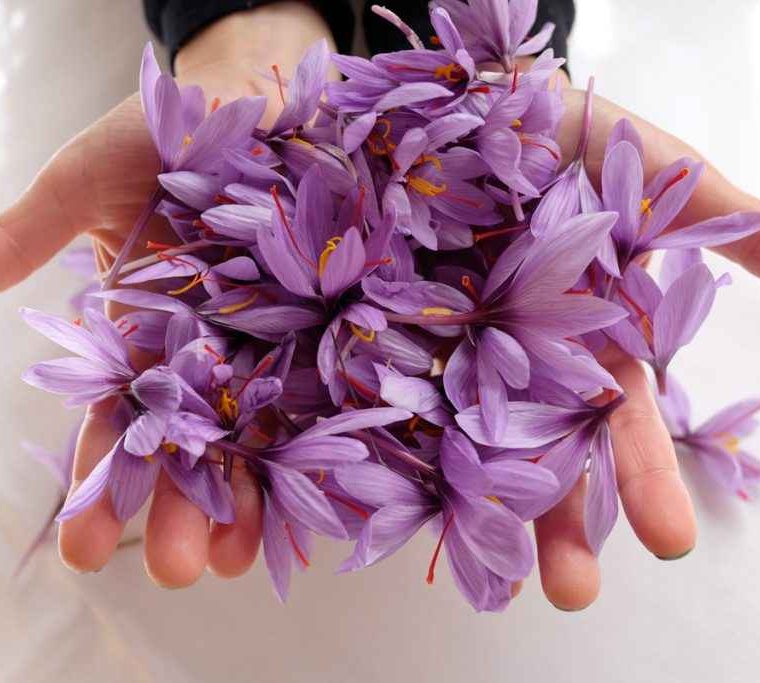You might wonder whether saffron petals have similar properties to saffron itself. In this article, we will explore the properties of saffron petals.
Properties of Saffron Petals
What are saffron petals, and what are their uses?
A saffron flower typically contains three red threads, known as stigmas, though sometimes there are more. Alongside these stigmas are yellow stamens and purple petals, which are often discarded. However, recent research has shown that the properties of saffron’s purple petals are by no means inferior to those of its expensive stigmas. This has recently drawn more attention to saffron petals, leading people to use them as herbal tea. Research findings have revealed that in China, saffron petals are used to treat various ailments.
Moreover, saffron petals are not only beneficial for health but also have uses in different industries. Particularly in the production of natural dyes for coloring clothes and carpets, saffron petals are recognized as a high-quality natural dye. The color derived from saffron petals is due to the presence of anthocyanins.
These colors can be used in both liquid and powder forms, and interestingly, they are entirely edible, making them suitable for decorating foods and desserts. One advantage of these colors is that they are harmless to health and are more affordable than saffron stigmas.
Therefore, using saffron petals allows you to obtain a natural, high-quality dye at a lower cost compared to saffron stigmas.
Key Benefits of Saffron Petals:
1. Heart Disease Treatment
Saffron has high antioxidant properties that help maintain heart health. Saffron petals also have radical-scavenging properties, making them effective against free radicals harmful to the heart and body.
2. Cancer Treatment Support
Saffron contains antioxidant and functional compounds that can aid in the cancer recovery process. The anthocyanins in saffron create purple, blue, and red colors and are recognized as anti-cancer agents. The most significant positive effects of saffron petals have been observed in fighting liver cancer.
3. Relief of Menstrual Pain
If you experience pain during menstruation, drinking saffron petal tea can help relieve this pain and is an excellent menstrual regulator.
4. Treatment of Neurological Disorders and Depression
Saffron petals contain active molecules of phenolic compounds that help reduce pain and induce happiness. The compounds in saffron can aid in treating depression and positively impact mood by regulating hormones related to neurotransmission.
5. Blood Pressure Reduction
Due to the presence of anthocyanins, saffron petals have calming properties and can help lower blood pressure.
6. Cosmetic and Health Applications
The properties of saffron petals have extended to the cosmetic and health industries, where they can be used as anti-wrinkle agents and in the production of cosmetic products like eyeshadows and lipsticks.
7. Liver Detoxification
The antioxidant compounds in saffron petals can help reduce liver inflammation and prevent damage to liver cells.
8. Pain and Inflammation Reduction
Saffron petals help reduce muscle, joint, and dental pain and can alleviate various types of inflammation.
9. Anti-Spasmodic and Muscle Cramp Relief
Saffron petals can help treat muscle cramps and, with their magnesium and phosphorus content, strengthen the nervous system and prevent muscle spasms.
Other Benefits of Saffron Petals:
– Preventing blindness
– Facilitating menstruation
– Reducing muscle pain
– Enhancing intelligence
– Preventing hair loss
– Improving sleep patterns
– Treating Alzheimer’s
Saffron Flower Products
Many people believe that only the red saffron stigmas are usable, but this is not true. A saffron flower consists of 6 petals, 3 yellow stamens, and a three-branched red stigma, each with its specific applications and properties.
Various Uses of Saffron Products:
– Saffron threads: Used in the food and pharmaceutical industries.
– Yellow stamens: Used in the production of ice cream and sweets.
– Saffron petals: Used in the preparation of anti-depressant and invigorating teas.
– Saffron roots: Used in the food and confectionery industries.



